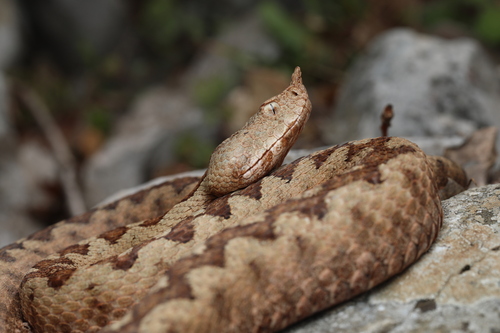
Horned Viper
The Vipera ammodytes, or horned viper, is famed for its unique nasal horn. Its excellent camouflage allows it to ambush prey efficiently, vital for maintaining ecological balance in Southern Europe's rocky landscapes. A fascinating predator with a pivotal role in rodent control.
22 years
Lifespan
Length: 76 - 91 cm
Size
Grey, Black, Dark, Brown
Color
Low
Aggression
Least Concern
Conservation Status
Decreasing
Population Trend
Characteristics
Vipera ammodytes, commonly known as the horned viper, is a venomous snake found in Southern Europe. It inhabits rocky terrains and scrublands. Notable for a distinctive horn-like scale on its snout, it exhibits effective camouflage and ambush predation tactics. This viper plays a crucial role in controlling local rodent populations.
Distribution Range of the Horned Viper
Vipera ammodytes, commonly known as the nose-horned viper, is native to southeastern Europe and parts of the Middle East. Its geographical distribution spans across countries such as Italy, Slovenia, Croatia, Bosnia and Herzegovina, Serbia, Montenegro, North Macedonia, Albania, Greece, Bulgaria, Romania, Hungary, and extending into the Middle East, including Turkey.
Horned Viper's Habitat
Environmental Conditions
This species typically inhabits rocky hillsides, scree slopes, and dry stone walls. It is commonly found in regions with a Mediterranean climate, characterized by hot, dry summers and mild, wet winters. The nose-horned viper often resides in areas with a mixture of forested and open spaces, allowing it to thermoregulate effectively.
Ecological Niche
Vipera ammodytes is an ambush predator, playing a crucial role in controlling the populations of small mammals, birds, and lizards. Its ecological niche involves occupying both terrestrial and semi-arboreal environments, often found basking on rocks or hidden under vegetation. The species is well-adapted to its environment, with cryptic coloration aiding in camouflage from both predators and prey.
Copyright @ Nature Style Limited. All Rights Reserved.
 English
English